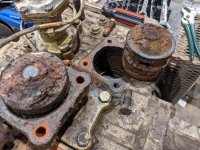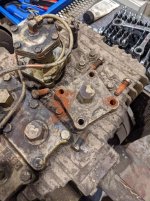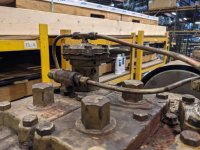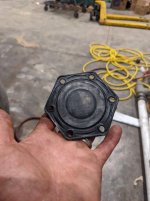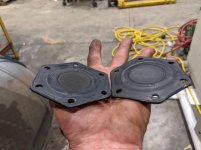Zac Penn
Plastic
- Joined
- Oct 4, 2019
- Location
- Jacksonville
I got this from an auction a couple years ago. It looked rough but when it was installed, it made pressure just like it should. However, I was cheap when I installed it and used a 25amp contactor that ended up getting burnt out. After that, it sat for about 6+ months until I decided I wanted to actually put it into service.
I then bought a 50amp contactor and drained the old oil, which was quite milky. I used some 10W30 motor oil as a temporary lubricant to help flush out any extra water that was in the drain pan. I drained all of the water that is in the 200 gal tank and then the circuit breaker back on to get it running again. I left the water drain open for a while to make sure I got everything out. I opened up the 3/4" ball valve on the tank to see what kind of air volume was going generated by the compressor and I feel like it was a substantial amount of air being pumped. I then closed the valve and waited for the pressure to build but it wouldn't go above 20 PSI on the gauge. I let it run for 10 minutes and never went higher so I just shut it down.
I had ordered some Ingersoll Rand synthetic compressor oil as a long term solution but when I drained the cheap oil it looked more milky than I expecting. I am going to refill it with cheap motor oil again and flush it out one more time so that i don't contaminate my expensive compressor oil with the water that is still inside the pump.
This is my 1st industrial compressor so i have zero experience with what things to check and in what order, to narrow down the pressure issue.
The oil pressure gauge appears to be normal, arrow is right in the middle around 15PSI, and it seems like the unloader is working properly but I don't really know for sure if that is the case. Would it make ANY pressure if the unloader was stuck open?
Anyways, I figured you guys would have some advise for me. If you can be as detailed as possible in your replies I would truly appreciate it. Like I said earlier, I am a novice with these machines so i am going to need some hand holding and laymans speak to get me through this.
Thanks in advance,
Zac
I then bought a 50amp contactor and drained the old oil, which was quite milky. I used some 10W30 motor oil as a temporary lubricant to help flush out any extra water that was in the drain pan. I drained all of the water that is in the 200 gal tank and then the circuit breaker back on to get it running again. I left the water drain open for a while to make sure I got everything out. I opened up the 3/4" ball valve on the tank to see what kind of air volume was going generated by the compressor and I feel like it was a substantial amount of air being pumped. I then closed the valve and waited for the pressure to build but it wouldn't go above 20 PSI on the gauge. I let it run for 10 minutes and never went higher so I just shut it down.
I had ordered some Ingersoll Rand synthetic compressor oil as a long term solution but when I drained the cheap oil it looked more milky than I expecting. I am going to refill it with cheap motor oil again and flush it out one more time so that i don't contaminate my expensive compressor oil with the water that is still inside the pump.
This is my 1st industrial compressor so i have zero experience with what things to check and in what order, to narrow down the pressure issue.
The oil pressure gauge appears to be normal, arrow is right in the middle around 15PSI, and it seems like the unloader is working properly but I don't really know for sure if that is the case. Would it make ANY pressure if the unloader was stuck open?
Anyways, I figured you guys would have some advise for me. If you can be as detailed as possible in your replies I would truly appreciate it. Like I said earlier, I am a novice with these machines so i am going to need some hand holding and laymans speak to get me through this.
Thanks in advance,
Zac









